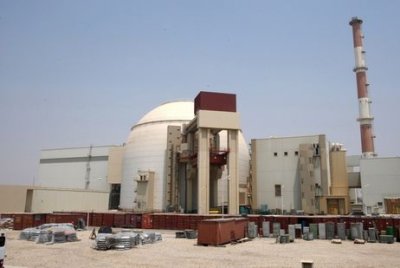
This is a view in 2010 of Iranian nuclear power plant in Bushehr, southern Iran. File photo by Abedin Taherkenareh/EPA/EFE
May 31 (UPI) — Iran has increased production of highly enriched uranium, according to the United Nations nuclear watchdog, as the nation conducts talks with the United States on a nuclear deal.
The International Atomic Energy Agency said the Middle East country now possesses more than 408.6 kilograms, or 900 pounds, of uranium enriched to 60% purity as of May 17, according to a confidential report obtained by the BBC and Al Jazeera.
That’s a nearly 50% increase since February.
In December, the IAEA said Iran was rapidly moving closer to the 90% threshold needed for weapons-grade material.
This is enough for about 10 nuclear weapons if further refined.
Iran is the only non-nuclear-armed state producing uranium at this level.
“The significantly increased production and accumulation of highly enriched uranium by Iran … is of serious concern,” IAEA Director General Rafael Grossi said.
IAEA concluded that Tehran conducted nuclear activities at three previously unknown sites: Lavisan-Shian, Varamin, Turquzabad.
And IAEA stated said it “cannot verify” the development of nuclear weapons, citing Iran’s refusal to grant access to senior inspectors and not answer questions about its nuclear history.
The IAEA board plans to meet in the coming days to discuss next steps.
Iran has long said its nuclear enrichment is for peaceful purposes.
“If the issue is nuclear weapons, yes, we too consider this type of weapon unacceptable,” Iranian Foreign Minister Abbas Araghchi said in a televised speech. “We agree with them on this issue.”
Israeli Prime Minister Benjamin Netanyahu said Saturday in a statement that Iran is “totally determined” to acquire nuclear weapons.
“Such a level of enrichment exists only in countries actively pursuing nuclear weapons and has no civilian justification whatsoever,” Netanyahu’s office said.
U.S. officials estimate Ian could produce weapons-grade material in less than two weeks and potentially build a bomb within months.
Since talks began in April, both sides have expressed optimism but are divided over key issues, including whether Iran can continue enrichment under any future agreement.
Two of Supreme Leader Ayatollah Ali Khamenei‘s advisors — Ali Larijani and Kamal Kharazi — have suggested Iran might reconsider building nuclear weapons if international pressure mounts.
The IAEA findings could be a negotiation tool for Iran, Hamed Mousavi, professor of political science at Tehran University, told Al Jazeera.
“I think both sides are trying to build leverage against the other side,” he said. “From the Iranian perspective, an advancement in the nuclear program is going to bring them leverage at the negotiation table with the Americans.
“Enriching up to 60% – from the Iranian perspective – is a sort of leverage against the Americans to lift sanctions.”
He said the U.S. could threaten more sanctions and refer the situation to the U.N. Security Council for its breach of the 2006 non-proliferation agreement.
On Wednesday, U.S. President Donald Trump said he sees a nuclear deal with Iran that would allow the destruction of labs and inspections. Iran has rejected inspections.
He said a deal is “very strong, where we can go in with inspectors. We can take whatever we want. We can blow up whatever we want. But nobody getting killed.”
In 2018, Trump unilaterally exited the Joint Comprehensive Plan of Action and reimposed harsh sanctions.
In 2015, Iran reached a deal with the U.S., Britain, Germany, France, Russia, China and the European Union.
Some sanctions on Iran were lifted for limits on its nuclear development program.